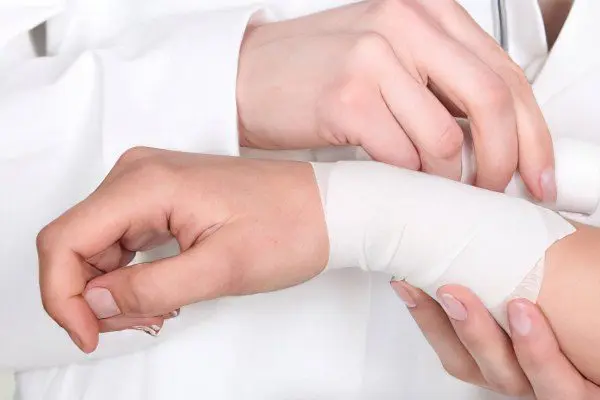Contents
The leakage of blood from small vessels into the body cavity or into the external environment is capillary bleeding. It occurs when the vessels of the mucous membranes, muscle tissue and skin are damaged.
With capillary bleeding, saturated red blood flows out evenly over the entire wounded surface or in a small stream.
Such bleeding is rarely life-threatening and usually stops on its own, but can be profuse.
Why is capillary bleeding dangerous for a person?

An important function of blood is the transport of oxygen and nutrients. They are delivered to tissues, and from there metabolic products and carbon dioxide are carried away. With minor damage to the capillaries and shallow wounds, there is no threat to health. However, with extensive capillary bleeding, this vital function is disrupted, resulting in oxygen deficiency. First of all, the heart muscle and nervous system suffer from oxygen starvation, which threatens life.
First aid for capillary bleeding is necessary not only in case of serious injuries, but also if the blood comes from the nose, ear, gums, digestive tract, uterus and other organs.
The main distinguishing feature of capillary bleeding is the slow release of blood over the entire wound surface. There are two types of capillary bleeding: internal (the most dangerous of them are uterine, intestinal and gastric) and external.
Specialists identify several causes of capillary bleeding, including traumatic, coagulopathic and pathological:
Diseases of the blood coagulation system are hemophilia, thrombocytopenic purpura, von Willebrand disease;
Traumatic injuries (abrasions, burns, cuts). According to the classification, they are divided into thermal, which arise from exposure to critically high temperatures, and mechanical, which occur in the event of various extreme situations (catastrophes, falls, fights);
Vascular diseases, in which the skin and tissues are damaged (tumors, purulent inflammations of the skin involving capillaries);
General diseases (oncological processes, rheumatoid arthritis, multiple sclerosis, necrosis, atherosclerosis), in which the vascular walls throughout the body are affected. As a result, plasma and blood cells leak out and extensive internal capillary bleeding occurs;
Disorders of hormonal functions.
Internal capillary bleeding over time can lead to the formation of interstitial and intraarticular hematomas. Such bleeding from parenchymal organs (liver, spleen, brain) is of great danger when they are damaged.
How to stop capillary bleeding?
Timely first aid for capillary bleeding contributes to its temporary or complete cessation. Ways to stop bleeding depend on its intensity and consist in the imposition of a pressure bandage, tamponade, and the application of cold. In most cases, such bleeding does not cause extensive blood loss, but it is dangerous for infection with pathogenic bacteria.
In the event of a wound on the arm or leg, assistance should be provided as follows:
Raise the injured limb above the level of the heart – the pressure in the vessels decreases, which leads to a stop or a significant decrease in bleeding;
When wounding a small area, to prevent infection, it is necessary to lubricate the skin around the wound with iodine or treat it with 3% hydrogen peroxide. For the fastest healing, a bactericidal patch is fixed on top;
With a bandage or gauze in several layers, apply a pressure bandage. Bandaging must be done from the bottom up, after two layers of bandage, apply a cotton swab and continue bandaging. If the bandage is saturated with blood, it is not necessary to remove the bandages, several more layers should be applied on top;
With an extensive wound, the maximum flexion of the joint located above the wound helps to temporarily stop the bleeding, but the most reliable way is to apply a tourniquet. This is done as follows: as close as possible to the wound, but above it it is necessary to put a cloth or bandage, tighten the tourniquet on top and be sure to put a note under it with the exact time of application. In winter, the tourniquet is kept no longer than an hour, in the summer no longer than one and a half. After this time, it is necessary to loosen the tourniquet for 15 minutes and tighten again;
An ice pack should be applied to the wound to reduce pain and stop bleeding.
First aid for internal capillary bleeding into the abdominal cavity: lay the patient on his back, raise his legs and tilt his head back, apply ice to the site of the alleged bleeding and call an ambulance. Such actions help prevent shock, but in no case should you hesitate to contact a medical institution!
Nosebleeds – how to stop?

The mucous membrane of the nose is rich in tiny capillaries, so any injury can cause bleeding. They are distinguished by duration and intensity. Often, nosebleeds begin to flow for no apparent reason, but usually such bleeding is caused by a stroke, prolonged use of vasoconstrictor drops in the nose, fragility and weakness of blood vessels, sun or heat stroke, hypertension, or anatomical defects in the nasal cavity.
It is very simple to provide first aid for capillary bleeding from the nose, it is only important to do everything right:
The patient should be in an upright position, preferably sitting, and the head slightly tilted forward. This ensures that blood flows freely from the nostrils. You can’t tilt your head back, because blood flowing into the nasopharynx can cause vomiting or coughing, and this will only increase bleeding;
Apply ice to the nose area;
Press the wings of the nose against the septum for five minutes. This contributes to the formation of a blood clot;
Install a swab moistened with a solution of 3% hydrogen peroxide in the nasal passage.
It is advisable to perform all procedures with rubber gloves, or at least pre-disinfect your hands. With frequent nosebleeds, it is necessary to carry out regular preventive measures, strengthen blood vessels, take ascorutin or ascorbic acid.
Danger of nosebleeds
A condition in which blood is released from the nasal cavity can be a threat to human life if the cause is a serious illness or injury. It is necessary and very important to carry out a temporary stop of bleeding before arriving at the hospital. If the blood from the nose goes for more than half an hour and does not stop with the methods described above, and the volume of blood loss is more than 200 ml, you need to call an ambulance, regardless of the alleged causes of bleeding.









